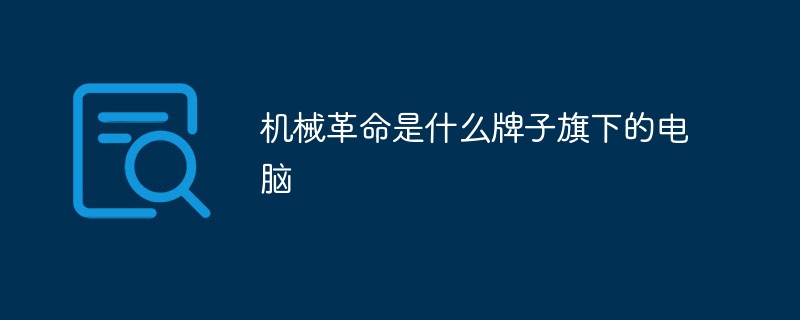 Common Problem
Common Problem When your USB C is not recognized by Windows 11, there are over 5 fixes to choose from.
When your USB C is not recognized by Windows 11, there are over 5 fixes to choose from.The USB-C connector is now standard on most modern phones, laptops, and tablets. In other words, we've entered the USB-C era, and the traditional rectangular USB Type-A plugs we've become accustomed to are slowly disappearing.
You can now charge your Windows 11 PC and communicate via USB-C connection with other USB Type-C gadgets that have USB-C ports (such as display adapters, docking stations, phones, etc.) .
Unfortunately, certain software and hardware combinations can cause problems. When this happens, you may see a message indicating that the USB-C connection failed.
In this article, we will show you how to fix any USB C not recognized issue on Windows 11. For some general USB fixes on Windows 11, read our tutorial on Windows 11 not recognizing USB devices.
What is USB Type-C?
In short, USB C is a specific USB connector with a cable and circuitry. USB C is used to transfer power and data just like any other USB cable.
The design of USB Type C is significantly different from that of its predecessor, USB A. The Type C is oval shaped and completely symmetrical, so there's no danger of accidentally plugging it into the wrong port. Here are the main features that distinguish USB C from other standard cables:
- Speed
- Power capabilities
- Supported data protocols
The transfer speed is determined by the device it is connected to. For example, a USB Type-C cable connected to a USB 3.1 port provides a transfer rate of 10 GB per second. The USB 3.2 connector will transfer data at 20 GB per second, while the Thunderbolt 3 port will reach 40 GB per second.
In terms of power, USB Type C can charge laptops, mobile phones, portable devices and power banks. Type C is the same as Type A and only produces 2.5 watts of power. However, if the device supports PD or Power Delivery, the USB-C port can deliver up to 100 watts of power.
What should I do when my Windows 11 computer doesn’t recognize USB C?
1. Restart your Windows 11 PC
Normally, Windows can detect USB C devices by simply restarting your Windows 11 PC.
This is the most direct option. Restarting your PC will clear RAM and get rid of background applications that may be interfering with your input/output devices.
It can improve the performance of your computer by correcting small defects. This is a great way to get started before moving on to anything more advanced.
If the problem persists after restarting several times, you should move to other solutions.
2. Reinstall your USB driver
- Right-click on the Start menu and select the Device Manager option.

- Expand Universal Serial Bus Device Options, right-click your device, and select Uninstall.

- Restart the computer.
When you restart your computer, the driver will be automatically reinstalled.
You can also take advantage of third-party programs to simplify driver upgrades and maintenance. DriverFix is a reliable option and highly recommended.
DriverFix scans your entire computer for missing or outdated drivers. After that, you can choose to update outdated drivers or re-download missing drivers. This powerful utility compares your drivers to a database of over 18 million files.
⇒ Get DriverFix
3. Clean your USB port
Use a paintbrush or microfiber cloth to clean the USB port and then try connecting again. Helps.
Over time, USB ports on your computer can become clogged with particles or dust. When this happens, your gadget may stop communicating and your Windows 11 will not recognize USB C.
4. Enable Trusted Devices
- Connect to your Windows 11 PC using a USB C cable.
- Click Trust when prompted by your phone.
Some gadgets, such as the iPhone, provide an additional layer of authentication to ensure the user's identity is verified.
Therefore, you must unlock your iPhone before connecting it to your Windows 11 PC for the first time. iOS will require the user to trust the linked device. Once authorized, your iPhone content will appear on your PC.
5. Edit Power Management Settings
- Right-click on the Start menu and select the Device Manager option.

- Expand the Universal Serial Bus device options, right-click your device, and select Properties.

- Navigate to the Power Management tab, uncheck Allow the computer to turn off this device to save power, and click OK.

6. Disable USB suspend settings
- Click the Start menu, type power plan, and selectEdit power planapp.

- Click Change Advanced Power Settings.

- Expand USB settings and select Disable under USB selective suspend settings.

7. Scan your PC for viruses
- Click the Start menu, type Windows Security, and then select the Windows Security app.

- Click Virus & Threat Protection in the left pane and select the Quick Scan option on the right.

While the application is scanning, you can minimize the window and continue whatever work you are doing on your PC.
8. Check for Windows Updates
- Click the Start menu, type Windows Update, and then select the Windows Update Settings option.

- If there are any updates, click Download and Install.

- Restart your computer.
9. Replace your USB C device
If you verify that the USB C port is working, the problem may be with the device you are connecting to. If Windows does not detect the device, you may consider replacing it with another device.
Our tutorial on the best USB C drives is a helpful resource for finding the best type or alternatives.
For example, a USB hard drive can only be recognized if the device is not faulty. So before you consider switching devices, make sure you test on another computer (if possible).
Unfortunately, it is difficult to determine why a USB device has stopped functioning. To explore, you should review your device's user manual or, if available, explore your device's manufacturer help options.
Like many PC glitches, you don't need a technician when Windows 11 doesn't recognize your USB C; you can just follow the solutions above to get your PC running perfectly again.
Please note that these fixes are not in any particular order, but we strongly recommend that you try all solutions before purchasing or replacing a USB C device.
The above is the detailed content of When your USB C is not recognized by Windows 11, there are over 5 fixes to choose from.. For more information, please follow other related articles on the PHP Chinese website!
 电脑除号是哪个键Feb 20, 2023 pm 12:27 PM
电脑除号是哪个键Feb 20, 2023 pm 12:27 PM电脑除号是显示“/”符号的键,这个键在笔记本键盘右侧的SHIFT键的左边;除号是个数学符号,是一个由一根短横线和横线两侧的两点构成的符号,其主要用来表示数学中的除法运算;除号可运用到数学、物理学、化学等多领域。
 电脑屏幕有条纹并闪烁怎么办Feb 24, 2023 pm 02:23 PM
电脑屏幕有条纹并闪烁怎么办Feb 24, 2023 pm 02:23 PM电脑屏幕有条纹并闪烁的原因及解决办法:1、显卡故障所致,可以及时关闭电脑,使电脑的显卡缓冲过来;2、外部磁场干扰,可以将计算机搬到一张四周都空荡荡的桌子上,然后进行开机测试;3、硬件或软件问题导致,维修硬件或重装系统;4、显示刷新频率设置不正确,可以将新频率设置为75以上即可。
 内存条坏了电脑能开机吗Feb 20, 2023 pm 02:10 PM
内存条坏了电脑能开机吗Feb 20, 2023 pm 02:10 PM内存条坏了电脑是不能开机的,内存条坏了具体会出现两种情况:1、无法正常开机,这种情况是内存故障中十分常见的一种,基本上都表现为开机时,机箱发出滴滴的警示音,无法进入系统或者显示器不亮;2、频繁出现蓝屏或死机等情况,在开机后出现蓝屏,大部分是内存错误,无法识别等。
 电脑开机后显示器显示无信号怎么办Feb 20, 2023 pm 02:36 PM
电脑开机后显示器显示无信号怎么办Feb 20, 2023 pm 02:36 PM电脑开机后显示器显示无信号的解决办法:1、检查主板灯是否亮,CPU风扇以及电源风扇是否转动;2、清除CMOS;3、把内存条取下来用橡皮擦一擦,再插上去;4、按紧主板上的BIOS芯片,使之接插紧密;5、更换一个主机电源。
 电脑开机闪一下就断电怎么办Feb 21, 2023 am 11:39 AM
电脑开机闪一下就断电怎么办Feb 21, 2023 am 11:39 AM电脑开机闪一下就断电的解决办法:1、把电源与主板之间的最大的插头拔下来,然后通电;2、找一根导线,将最大的插头中的绿色线与任意一根黑色线短路;3、修理主板或显卡即可。
 电脑跑分是什么意思Oct 12, 2022 am 10:53 AM
电脑跑分是什么意思Oct 12, 2022 am 10:53 AM电脑跑分是指通过跑分软件对电脑性能进行测试,会对电脑硬件性能出一个测试评分;其中会对单个硬件做出评分,对分数进行分析进而提出提升分数的配置方案,来提升电脑性能,跑分越高性能越好。跑分软件有3DMARK、鲁大师、360、腾讯电脑管家等。
 pc端是电脑还是手机Feb 20, 2023 pm 03:19 PM
pc端是电脑还是手机Feb 20, 2023 pm 03:19 PMpc端是电脑。pc全称Personal Computer,中文意思为个人计算机或者个人电脑;PC端是指网络世界里可以连接到电脑主机的那个端口,是基于电脑的界面体系,它有别于移动端的手机界面体系。
 机械革命是什么牌子旗下的电脑Nov 09, 2022 pm 02:09 PM
机械革命是什么牌子旗下的电脑Nov 09, 2022 pm 02:09 PM机械革命的英文品牌名称为“MECHREVO”,是清华同方股份公司旗下最具活力的消费类电脑品牌,其开办宗旨就是以精准打造年轻人喜爱的国货精品为己任,而且因为依托了同方成立至今20余年的技术储备,能够在国内进行自主设计、自主研发、自主生产,并整合了上下游优秀的供应链资源。

Hot AI Tools

Undresser.AI Undress
AI-powered app for creating realistic nude photos

AI Clothes Remover
Online AI tool for removing clothes from photos.

Undress AI Tool
Undress images for free

Clothoff.io
AI clothes remover

AI Hentai Generator
Generate AI Hentai for free.

Hot Article

Hot Tools

SublimeText3 Mac version
God-level code editing software (SublimeText3)

SublimeText3 Linux new version
SublimeText3 Linux latest version

SecLists
SecLists is the ultimate security tester's companion. It is a collection of various types of lists that are frequently used during security assessments, all in one place. SecLists helps make security testing more efficient and productive by conveniently providing all the lists a security tester might need. List types include usernames, passwords, URLs, fuzzing payloads, sensitive data patterns, web shells, and more. The tester can simply pull this repository onto a new test machine and he will have access to every type of list he needs.

WebStorm Mac version
Useful JavaScript development tools

SublimeText3 English version
Recommended: Win version, supports code prompts!

















